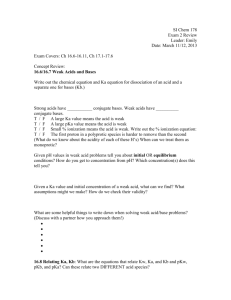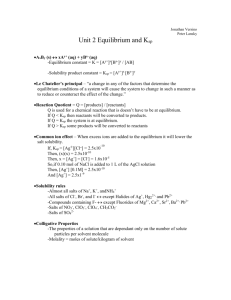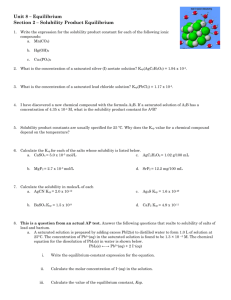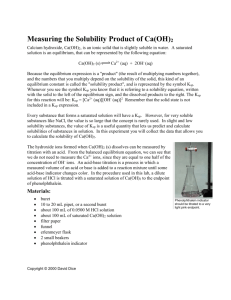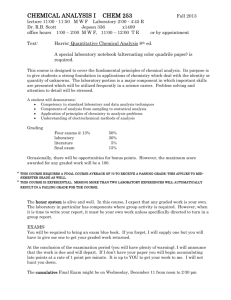Determining Ksp of Lead(II)
advertisement
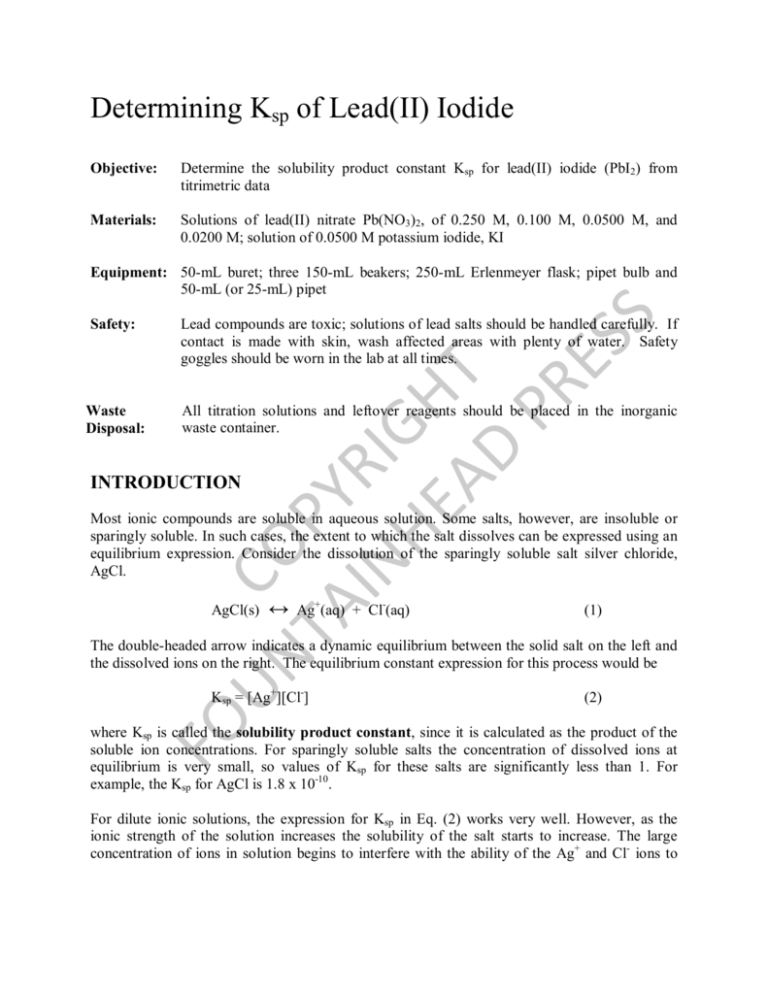
Determining Ksp of Lead(II) Iodide Objective: Determine the solubility product constant Ksp for lead(II) iodide (PbI2) from titrimetric data Materials: Solutions of lead(II) nitrate Pb(NO3)2, of 0.250 M, 0.100 M, 0.0500 M, and 0.0200 M; solution of 0.0500 M potassium iodide, KI UN CO TA PY IN RIG HE H AD T PR ES S Equipment: 50-mL buret; three 150-mL beakers; 250-mL Erlenmeyer flask; pipet bulb and 50-mL (or 25-mL) pipet Safety: Lead compounds are toxic; solutions of lead salts should be handled carefully. If contact is made with skin, wash affected areas with plenty of water. Safety goggles should be worn in the lab at all times. Waste Disposal: All titration solutions and leftover reagents should be placed in the inorganic waste container. INTRODUCTION Most ionic compounds are soluble in aqueous solution. Some salts, however, are insoluble or sparingly soluble. In such cases, the extent to which the salt dissolves can be expressed using an equilibrium expression. Consider the dissolution of the sparingly soluble salt silver chloride, AgCl. AgCl(s) ↔ Ag+(aq) + Cl-(aq) (1) The double-headed arrow indicates a dynamic equilibrium between the solid salt on the left and the dissolved ions on the right. The equilibrium constant expression for this process would be (2) FO Ksp = [Ag+][Cl-] where Ksp is called the solubility product constant, since it is calculated as the product of the soluble ion concentrations. For sparingly soluble salts the concentration of dissolved ions at equilibrium is very small, so values of Ksp for these salts are significantly less than 1. For example, the Ksp for AgCl is 1.8 x 10-10. For dilute ionic solutions, the expression for Ksp in Eq. (2) works very well. However, as the ionic strength of the solution increases the solubility of the salt starts to increase. The large concentration of ions in solution begins to interfere with the ability of the Ag+ and Cl- ions to interact and form the solid. In other words, the activity of the ions decreases as the ionic strength of solution increases. Under these conditions, a more appropriate form of the equilibrium constant expression would be Ksp = (AAg·)( ACl ) (3) where AAg· and ACl represent the activities of the Ag+ and Cl- ions, respectively. The ion activities are related to concentration by Equation (4). Ksp = (AAg·)( ACl ) = (γAg [Ag+])(γCl [Cl-]) (4) UN CO TA PY IN RIG HE H AD T PR ES S where γAg and γCl represent the activity coefficients of the Ag+ and Cl- ions. The activity coefficient acts as a correction factor to account for decreases in ionic activity at high ionic strengths. While a detailed study of activity coefficients is beyond the scope of this exercise, some general observations will be useful. For very dilute ionic solutions the value of the activity coefficient approaches unity, and Eq. (4) is identical to Eq. (2). As the ionic strength of the solution increases, the activity coefficient decreases. The ion product in Eq. (2), however, would increase. By including the activity coefficients in the Ksp expression the value of Ksp remains constant. The equilibrium point for Eq. (1) can be approached from either direction. If we add solid AgCl to solution, for example, the salt will dissolve until the ion product in Eq. (4) is equal to Ksp. Alternatively, we can mix solutions containing Ag+ and Cl- ions; when the ion product exceeds the value of Ksp then solid AgCl will precipitate from solution. Using this second approach, we can estimate the value of Ksp for a sparingly soluble salt by performing a titration, as illustrated in Example 1. Example 1: Consider a 100.0 mL solution of silver nitrate having an initial [Ag+] = 0.0010 M. A 0.00025 M solution of KCl is added dropwise until the first appearance of the white AgCl precipitate. The total volume of KCl added was 1.18 mL. Estimate the value of Ksp using the titration data. Solution Since the volume of the solution changes as titrant is added, we will need to calculate the actual concentrations of Ag+ and Cl- at the endpoint of the titration. We can calculate these concentrations using Equations (5) and (6). �𝑀𝑀𝐴𝐴𝑔𝑔+ ��𝑉𝑉𝐴𝐴𝑔𝑔+ � (𝑚𝑚𝑚𝑚𝑚𝑚𝑚𝑚𝑚𝑚 𝑜𝑜𝑜𝑜 𝐴𝐴𝑔𝑔+ ) (0.0010 𝑀𝑀)(0.100 𝐿𝐿) = = = 9.88 𝑥𝑥 10−4 (5) (𝑡𝑡𝑡𝑡𝑡𝑡𝑡𝑡𝑡𝑡 𝑣𝑣𝑣𝑣𝑣𝑣𝑣𝑣𝑣𝑣𝑣𝑣) �𝑉𝑉𝐴𝐴𝑔𝑔+ � + (𝑉𝑉𝐶𝐶𝑙𝑙 − ) (0.100 𝐿𝐿) + (0.00118 𝐿𝐿) FO [𝐴𝐴𝑔𝑔+ ]𝑒𝑒𝑒𝑒 = [𝐶𝐶𝑙𝑙 − ]𝑒𝑒𝑒𝑒 = (𝑚𝑚𝑚𝑚𝑚𝑚𝑚𝑚𝑚𝑚 𝑜𝑜𝑜𝑜 𝐶𝐶𝑙𝑙 − ) (𝑀𝑀𝐶𝐶𝑙𝑙 − )(𝑉𝑉𝐶𝐶𝑙𝑙− ) (0.00025 𝑀𝑀)(0.00118 𝐿𝐿) = = = 2.92 𝑥𝑥 10−6 (6) (𝑡𝑡𝑡𝑡𝑡𝑡𝑡𝑡𝑡𝑡 𝑣𝑣𝑣𝑣𝑣𝑣𝑣𝑣𝑣𝑣𝑣𝑣) �𝑉𝑉𝐴𝐴𝑔𝑔+ � + (𝑉𝑉𝐶𝐶𝑙𝑙 − ) (0.100 𝐿𝐿) + (0.00118 𝐿𝐿) We can now estimate the value of Ksp as the ion product using Eq. (2). Ksp = [Ag+][Cl-]= (9.88 x 10-4)(2.92 x 10-6) = 2.89 x 10-9 While we can obtain estimates of Ksp from the ion product, as shown in the Example, we need to be able to correct for the variations in ionic activity with ionic strength. One way to do this is to perform a series of titrations in which the initial concentration of one of the ions is varied. At higher initial concentrations, the ion product will be greater than the true Ksp. As the initial concentration is decreased, the value of the ion product will also decrease and approach the true value of Ksp If we plot the ion product vs. the initial concentration of the ion in solution, we can extrapolate to an initial concentration of zero. The y-intercept of this plot should be equal to Ksp. Titration of Lead(II) Iodide UN CO TA PY IN RIG HE H AD T PR ES S In this lab exercise we will determine the Ksp of lead(II) iodide by titration. The solubility equilibrium and Ksp expression for this insoluble salt are: PbI2(s) ↔ Pb2+(aq) + 2I-(aq) (7) Ksp = (γPb[Pb2+])(γI[I-])2 (8) We can perform a series of titrations using a 0.0500 M KI solution as titrant, and varying the initial concentration of Pb(NO3)2 in our sample.We will add titrant dropwise until the first appearance of pale-yellow lead(II) iodide (PbI2) signals the end point.We can calculate the concentrations of Pb2+ and I- ions at the end point using Equations (9) and (10). [𝑃𝑃𝑏𝑏2+ ]𝑒𝑒𝑒𝑒 = [𝐼𝐼 − ]𝑒𝑒𝑒𝑒 = (𝑚𝑚𝑚𝑚𝑚𝑚𝑚𝑚𝑚𝑚 𝑜𝑜𝑜𝑜 𝑃𝑃𝑏𝑏2+ ) (𝑀𝑀𝑃𝑃𝑏𝑏2+ )𝑖𝑖𝑖𝑖𝑖𝑖𝑖𝑖𝑖𝑖𝑖𝑖𝑖𝑖 (𝑉𝑉𝑃𝑃𝑏𝑏2+ )𝑖𝑖𝑖𝑖𝑖𝑖𝑖𝑖𝑖𝑖𝑖𝑖𝑖𝑖 = (𝑡𝑡𝑡𝑡𝑡𝑡𝑡𝑡𝑡𝑡 𝑣𝑣𝑣𝑣𝑣𝑣𝑣𝑣𝑣𝑣𝑣𝑣) (𝑉𝑉𝑃𝑃𝑏𝑏2+ )𝑖𝑖𝑖𝑖𝑖𝑖𝑖𝑖𝑖𝑖𝑖𝑖𝑖𝑖 + (𝑉𝑉𝐼𝐼− )𝑎𝑎𝑎𝑎𝑎𝑎𝑎𝑎𝑎𝑎 (𝑚𝑚𝑚𝑚𝑚𝑚𝑚𝑚𝑚𝑚 𝑜𝑜𝑜𝑜 𝐼𝐼 − ) (𝑀𝑀𝐾𝐾𝐾𝐾 )𝑖𝑖𝑖𝑖𝑖𝑖𝑡𝑡𝑡𝑡𝑡𝑡𝑡𝑡 (𝑉𝑉𝐾𝐾𝐾𝐾 )𝑎𝑎𝑎𝑎𝑎𝑎𝑎𝑎𝑎𝑎 = (𝑡𝑡𝑡𝑡𝑡𝑡𝑡𝑡𝑡𝑡 𝑣𝑣𝑣𝑣𝑣𝑣𝑣𝑣𝑣𝑣𝑣𝑣) (𝑉𝑉𝑃𝑃𝑏𝑏2+ )𝑖𝑖𝑖𝑖𝑖𝑖𝑖𝑖𝑖𝑖𝑖𝑖𝑖𝑖 + (𝑉𝑉𝐼𝐼− )𝑎𝑎𝑎𝑎𝑎𝑎𝑎𝑎𝑎𝑎 (9) (10) Since we don’t know the values of the activity coefficients in Eq. (8), we will calculate the ion product, [Pb2+][I-]2. At high initial concentrations of Pb2+ the ion product will be greater than Ksp. As the initial concentration of Pb2+ decreases, the ion product will approach a constant value of Ksp. Plotting the ion product vs [Pb2+]initial yields a graph similar to Figure 1. Extrapolating to the y-intercept (at which [Pb2+]initial = 0) allow us to estimate the value of Ksp for PbI2. FO The plot in Figure 1 is unsatisfactory for two reasons. First, due to curvature in the trend line as we approach the intercept there may be considerable error in our extrapolated value. Second, the value of Ksp on the graph is exceedingly small; the extrapolation approaches a value of zero. The extrapolated value of Ksp is too small to be shown accurately on the graph. The shortcomings of the plot in Figure 1 can be overcome by plotting the data in a different fashion. The best choice of functions to be plotted may be based on theory, intuition, or trial-anderror. In this case, the Debye-Hückel theory of dilute ionic solutions has shown that the best plot is log([Pb2+][I-]2) vs �[𝑃𝑃𝑏𝑏2+ ]/ �1 + �[𝑃𝑃𝑏𝑏2+ ]�. Theory predicts that this plot will become linear as ion concentrations are more dilute. Linear plots are easier to extrapolate. Also, the y-axis is logarithmic, so that there is less error in the estimate of Ksp obtained by extrapolation. The value of Ksp can be calculated as the antilog of the intercept, as shown in Equation (11). 𝐾𝐾𝑠𝑠𝑠𝑠 = 10��𝑃𝑃𝑏𝑏 2+ �[𝐼𝐼 − ]2 � (11) (Note that the antilog function in Eq. (11) would be used if the data were plotted using log10. If natural logs (ln) were used, then Eq. (11) would be calculated using ex as the antilog function.) The percent error in your calculated Ksp can be determined using Equation (12). �𝑎𝑎𝑎𝑎𝑎𝑎𝑎𝑎𝑎𝑎𝑎𝑎𝑎𝑎𝑎𝑎 𝐾𝐾𝑠𝑠𝑠𝑠 � − �𝑒𝑒𝑒𝑒𝑒𝑒𝑒𝑒𝑒𝑒𝑒𝑒𝑒𝑒𝑒𝑒𝑒𝑒𝑒𝑒𝑒𝑒𝑒𝑒 𝐾𝐾𝑠𝑠𝑠𝑠 � �𝑎𝑎𝑎𝑎𝑎𝑎𝑎𝑎𝑎𝑎𝑎𝑎𝑎𝑎𝑎𝑎 𝐾𝐾𝑠𝑠𝑠𝑠 � 𝑥𝑥 100 (12) UN CO TA PY IN RIG HE H AD T PR ES S % 𝑒𝑒𝑒𝑒𝑒𝑒𝑒𝑒𝑒𝑒 = 3.50E-06 3.00E-06 (ion product) 2.50E-06 2.00E-06 1.50E-06 1.00E-06 5.00E-07 0.00E+00 0 0.05 0.1 0.15 0.2 0.25 [Pb2+], initial FO Figure 1. Possible extrapolation of data to find Ksp of PbI2. 0.3 Pre-Lab Questions 1. A student followed the procedure of this experiment to determine the Ksp of zinc(II) iodate, Zn(IO3)2. Solutions of Zn(NO3)2 of known concentrations were titrated with 0.200 M KIO3 solutions to the first appearance of a white precipitate. For each of the zinc(II) nitrate solution concentrations below, calculate the expected concentration of iodate that would be required to initiate precipitation of zinc(II) iodate. Show all calculations. (Assume that Ksp = 3.9 x 10-6 at 25ºC for zinc(II) iodate). UN CO TA PY IN RIG HE H AD T PR ES S a) 0.100 M Zn(NO3)2: b) 0.0100 M Zn(NO3)2: a) b) FO 2. Assuming that you performed the titrations described above using 100.00 mL samples of zinc nitrate, what volumes of 0.200 M potassium iodide would be required to initiate precipitation in each case? To simplify the calculations, neglect dilution effects from the added potassium iodate and assume a total final solution volume of 100.00 mL. 3. The actual volumes of 0.200 M potassium iodate required when the student performed the experiment were 7.54 mL and 17.82 mL, respectively. Explain. PROCEDURE Note: Students may perform individual titrations for each lead(II) nitrate solution concentration or may perform replicate titrations for one or more assigned lead(II) nitrate solution concentrations, depending on time constraints. 1. Obtain a 50-mL buret. Clean with soap solution, rinse thoroughly, and place it in a buret clamp to drain. UN CO TA PY IN RIG HE H AD T PR ES S 2. Obtain about 100 mL of 0.050 M potassium iodide solution in a clean, dry, labeled 150-mL beaker. Rinse the 50-mL buret with about 10 mL of the potassium iodide solution, tilting and turning the buret so that the inside walls of the buret are contacted by the solution. Drain the KI solution from the buret through the buret tip. Repeat this process with two more 10-mL portions of KI solution. 3. Fill the buret with the KI solution so that the level of solution is above the zero mark on the buret. Gently tap the sides of the buret to remove any air bubbles that may be present in the solution. Carefully open the stopcock of the buret and allow the KI solution to fill the buret tip. Continue draining the KI solution until the level of the meniscus in the buret is at or below the zero mark. Record this volume reading to the nearest 0.05 mL on Data Sheet 1. 4. Obtain about 130 mL of the 0.250 M lead(II) nitrate solution in a clean, dry, labeled 150-mL beaker. Using a pipet bulb, draw about 10 mL of this solution up into the 25-mL or 50-mL pipet. Tilt the pipet while turning so that the solution comes into contact with the entire inside surface of the pipet. Drain this solution into a 150-mL waste beaker. Repeat this rinse with two more 10-mL portions of lead(II) nitrate solution. 5. Using the rinsed pipet, carefully transfer 100.0 mL of the 0.250 M lead(II) nitrate solution into a 250-mL Erlenmeyer flask. 6. Add KI solution dropwise from the buret to the lead(II) nitrate solution in the Erlenmeyer flask while stirring thoroughly. Continue adding KI solution until the first appearance of yellow PbI2 that remains after thorough mixing. Record the volume reading of the KI solution in the buret (to the nearest 0.05 mL) on Data Sheet 1. FO 7. Repeat Steps 4–6 for the 0.100 M, 0.0500 M, 0.0200 M, and 0.0100 M lead(II) nitrate solutions. You do not need to refill the buret before each titration, but should note the initial and final buret volume readings for each titration. If the volume reading in the buret approaches the 50.00 mL mark you should add more KI to ensure that you have enough titrant to complete the titration before you begin. 8. Dispose of all titration mixtures and excess reagent solutions in the inorganic waste container provided. 9. Submit your titration data to your TA. The TA will obtain class data and calculate the average volume of titrant used for each of the five titrations. Record the average class data for the five titrations on Data Sheet 2 before you leave lab. CALCULATIONS Record the results of all calculations in the appropriate spaces on Data Sheet 1 for your assigned titrations, and on Data Sheet 2 for the average class data. 1. Calculate the volume of titrant (KI) added to each titration solution as the difference between the initial and final buret volume readings. 2. Calculate the total volume of the titration solution at the end point as the sum of the added titrant and the initial volume of lead(II) nitrate solution. UN CO TA PY IN RIG HE H AD T PR ES S 3. Using the initial volume and molarity of the lead nitrate solutions, and the total volume of the solution at the endpoint, calculate the actual concentration of Pb2+ ion at the endpoint. 4. Using the molarity and volume of KI added, and the total volume of solution at the endpoint, calculate the actual concentration of I- ion at the endpoint. 5. Calculate the ion product of [Pb2+][I-]2 at the endpoint for each titration. 6. Calculate the log of each ion product. You may calculate either ln or log (base 10), as long as you are consistent for all calculations. 7. Repeat the calculations in Steps 3–6 for the average class data and record your results on Data Sheet 2. 8. Construct a graph by plotting the ion product (y-axis) vs. [Pb2+] (x-axis) using the average class data. Label this as Graph 1. Attempt to extrapolate the curve to zero concentration to find Ksp. Record this value of Ksp on Data Sheet 2. (Note: Extrapolated results can be improved by plotting the data using a spreadsheet, such as Excel, and adding a trend line (polynomial fit), and reporting the intercept of the trend line equation.) FO 9. Using the average class data, calculate values of �[𝑃𝑃𝑏𝑏2+ ]/ �1 + �[𝑃𝑃𝑏𝑏2+ ]� and log (ion product) using the average class data from Data Sheet 2. Construct another graph by plotting the log of the ion product vs �[𝑃𝑃𝑏𝑏2+ ]/ �1 + �[𝑃𝑃𝑏𝑏2+ ]�. Plot the points as small circles on the graph. Label this plot as Graph 2. Extrapolate the curve to zero concentration to find log Ksp. Calculate Ksp as the antilog of the intercept, and record this result on Data Sheet 2. As noted above, accuracy of Ksp estimations from extrapolation can be improved by plotting data using spreadsheet software, and using the trend line equation to find the intercept. 10. Repeat the calculations in Step 9 using your own titration results, and plot your data as small triangles on Graph 2. Compare your individual data with the average class data. 11. Compare the calculated value of Ksp from Graph 2 with an accepted literature value of Ksp for PbI2. Calculate % error using Eq. (12). Data Sheet 1 Individual Data [Pb(NO3)2]initial, M 0.250 0.100 0.0500 0.0200 0.0100 [KI]initial, M 0.0500 0.0500 0.0500 0.0500 0.0500 V of Pb(NO3)2 , mL 100.00 100.00 100.00 100.00 100.00 V of KI (initial), ml ________ ________ ________ ________ UN CO TA PY IN RIG HE H AD T PR ES S ________ V of KI at endpoint, mL ________ ________ ________ ________ ________ V of KI added, mL ________ ________ ________ ________ ________ Vtotal at endpoint, mL ________ ________ ________ ________ ________ [Pb2+], M ________ ________ ________ ________ ________ [I-], M ________ ________ ________ ________ ________ [Pb2+][I-]2 ________ ________ ________ ________ ________ log([Pb2+][I-]2) ________ ________ ________ ________ ________ ________ ________ ________ ________ ________ �[𝑃𝑃𝑏𝑏2+ ] 1+ �[𝑃𝑃𝑏𝑏2+ ] FO Sample Calculations: Data Sheet 2 Average Class Data 0.250 0.100 0.0500 0.0200 0.0100 [KI]initial, M 0.0500 0.0500 0.0500 0.0500 0.0500 V of Pb(NO3)2 , mL 100.00 100.00 100.00 100.00 100.00 V of KI added, mL ________ ________ ________ ________ ________ At Endpoint: UN CO TA PY IN RIG HE H AD T PR ES S [Pb(NO3)2]initial, M Vtotal at endpoint, mL ________ ________ ________ ________ ________ [Pb2+], M ________ ________ ________ ________ ________ [I-], M ________ ________ ________ ________ ________ [Pb2+][I-]2 ________ ________ ________ ________ ________ log([Pb2+][I-]2) ________ ________ ________ ________ ________ ________ ________ ________ ________ ________ �[𝑃𝑃𝑏𝑏2+ ] 1+ �[𝑃𝑃𝑏𝑏2+ ] Ksp of PbI2 from Graph 1: ________ Log(Ksp) from Graph 2: ________ FO Ksp from Graph 2: ________ Sample Calculations: % error in Ksp from Graph 2: ________ Post-Lab Questions 1. The % error in the extrapolated results is highly dependent on the error associated with the volume of the lead(II) nitrate solution used in each titration and the volume of potassium iodide solutions need to initiate precipitation in each trial. Given the data below, calculate the maximum % error associated with each of the typical measurements below. UN CO TA PY IN RIG HE H AD T PR ES S a) 100.00 mL of lead(II) nitrate solution measured using a 50.00 mL pipette with a tolerance of ± 0.05 mL b) 100.00 mL of lead(II) nitrate solution measured using a 100.00 mL volumetric flask with a tolerance of ± 0.02 mL c) 7.42 mL of potassium iodide solution titrated from a 50.00 mL buret with a tolerance of ± 0.02 mL FO 2. Based on the calculations in question 1, which measurement introduces the greatest error? Can you suggest at least one possible modification to the procedure to improve the precision associated with individual titration points? (Note: “Reducing human error” or “using better technique” are not acceptable responses.) 3. Discuss how each of the following conditions might affect the volume of 0.200 M potassium iodide needed to reach the precipitation end point in a typical titration. a) The lead(II) nitrate solution was prepared in 0.05 M NaCl instead of deionized water. b) The temperature in the lab increased by 3ºC.
